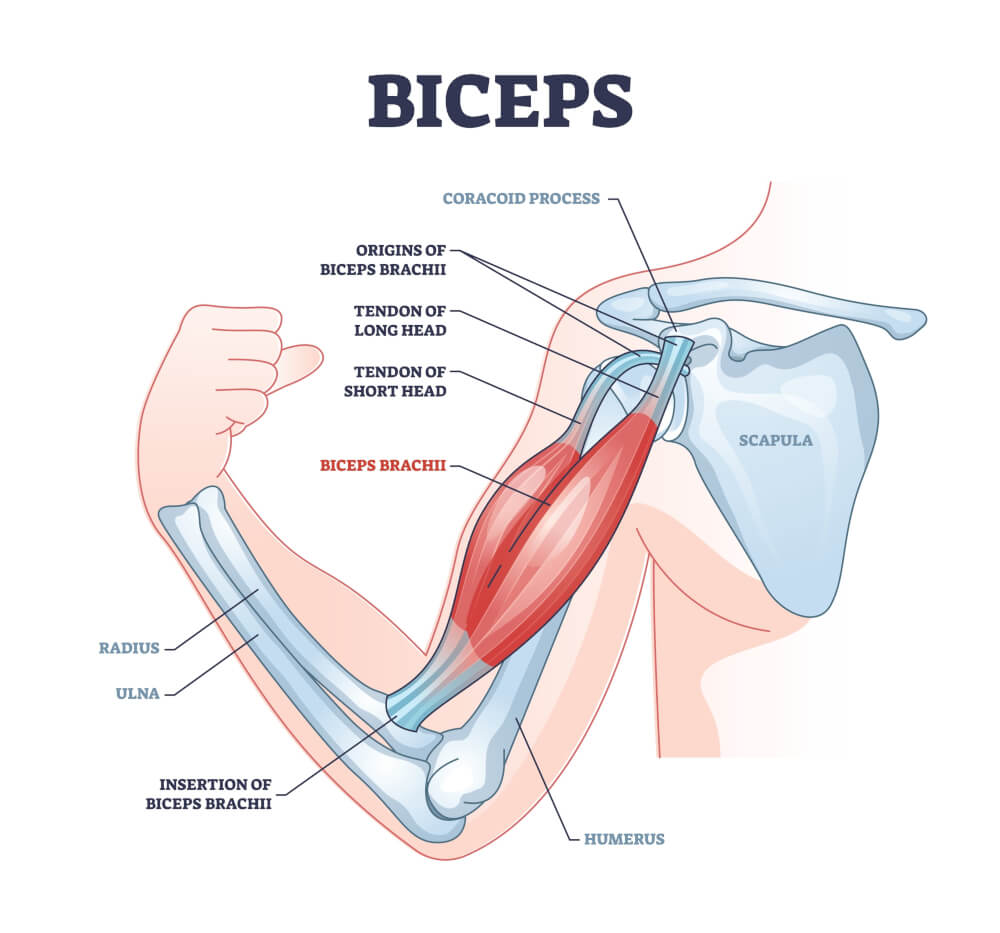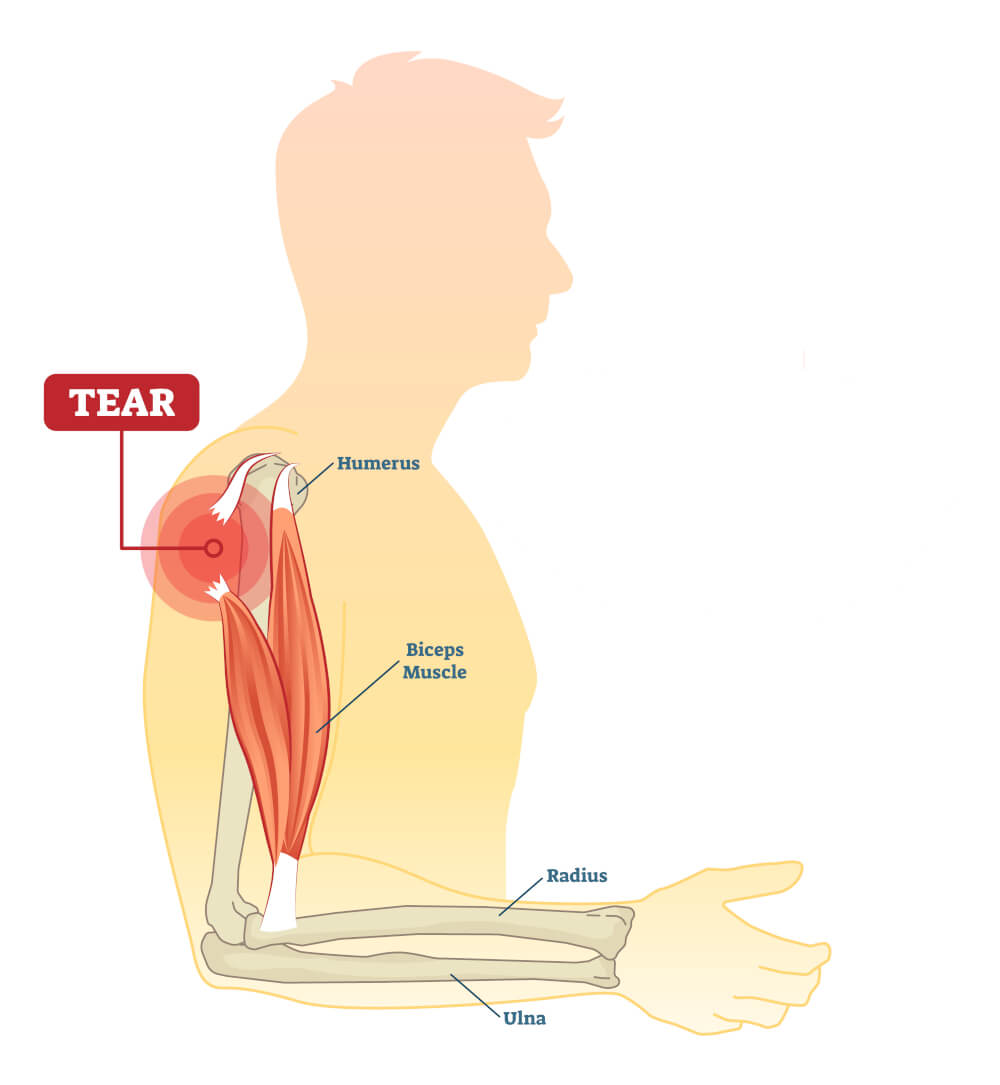Overview
A biceps tendon tear is a traumatic injury that occurs when the tendon that attaches the biceps muscle to the shoulder or elbow is partially or completely torn. The biceps muscle, located in the front of the upper arm, has two tendons – the long head and the short head – that attach to different points in the shoulder and elbow regions. A tear in one of these tendons can result in significant pain, weakness, and functional limitations.
If you have a question about whether your condition should be treated by one of our hand therapists, call Restored Hope Hand Therapy at (928) 275-2201.

Anatomy of the Biceps Tendon

Causes & Types of Biceps Tendon Tears
Biceps tendon tears can result from various causes, including:
- Trauma: A sudden force or impact to the arm, especially when the elbow is forcefully straightened against resistance, can lead to a biceps tendon tear.
- Overuse: Repetitive overhead activities or heavy lifting, common in certain sports or occupations, can contribute to wear and tear on the biceps tendon, making it more susceptible to injury.
- Age-related Changes: As individuals age, the tendons naturally undergo degenerative changes, becoming less elastic and more prone to injury. This degeneration can weaken the tendon and make it more susceptible to tearing.
Biceps tendon tears can be classified into two main types:
- Proximal Biceps Tendon Tears: These tears occur at the point where the long head of the biceps tendon attaches to the shoulder socket. A common cause is the wear and tear associated with aging, but it can also result from trauma or overuse.
- Distal Biceps Tendon Tears: These tears occur at the point where the biceps tendon attaches to the radius bone in the forearm, near the elbow. Distal tears are often the result of sudden, forceful bending of the elbow against resistance.
Symptoms
The symptoms of a biceps tendon tear can vary depending on the location and extent of the injury. Common signs and symptoms include:
- Sudden, Sharp Pain: A tearing sensation or sudden, sharp pain in the upper arm, especially during activities that engage the biceps muscle.
- Swelling and Bruising: Swelling around the shoulder or elbow, accompanied by bruising, may occur as a result of internal bleeding from the torn tendon.
- Weakness: Difficulty in flexing the elbow or lifting objects, indicating a loss of strength in the affected arm.
- Popeye Sign: In cases of a distal biceps tendon tear, a noticeable bulge may appear in the upper arm, giving the muscle a distinctive “Popeye” appearance as the biceps retracts.

Diagnosis and Treatment
Diagnosing a biceps tendon tear typically involves a thorough physical examination, medical history review, and imaging studies. X-rays may be used to rule out other potential causes of symptoms, while magnetic resonance imaging (MRI) can provide detailed images of the tendon and confirm the presence and extent of the tear.
Treatment options for biceps tendon tears depend on factors such as the severity of the tear, the patient’s age, activity level, and overall health. Conservative treatments may be recommended for partial tears or in cases where the individual is not a candidate for surgery. These may include rest, ice, anti-inflammatory medications, and physical therapy to improve strength and flexibility.
For more severe tears, particularly those causing significant functional impairment or cosmetic concerns (such as the Popeye sign), surgical intervention may be recommended. Surgical procedures may involve reattaching the torn tendon to its original attachment point or, in some cases, tenodesis, where the tendon is reattached to a different location.
Rehabilitation plays a crucial role in the recovery process, regardless of whether the approach is conservative or surgical. Shoulder therapy at our Prescott, AZ clinic can help restore range of motion, strength, and flexibility, enabling individuals to regain optimal function in the affected arm.
Schedule an Appointment Today
Don’t let shoulder pain or injury keep you in a bind. Reach out to Restored Hope Hand Therapy today and take a decisive step towards reclaiming your life from the clutches of shoulder pain. We are well-equipped to provide the support and professional guidance necessary for a successful rehabilitation journey. Call us today to schedule an appointment and embark on the path to recovery.
Shoulder Therapy Options
individualized-specific therapy programs to offer you the best possible results.
Shoulder
- Arthritis
- Avascular Necrosis (Osteonecrosis)
- Biceps Tendon Tear
- Breaks and Fractures
- Bursitis
- Chronic Shoulder Pain
- Dislocated Shoulder
- Frozen Shoulder
- Glenoid Labral Tear
- Rheumatoid Arthritis
- Rotator Cuff Injury
- Shoulder Separation
- SLAP Tear
- Strain & Sprains
- Swimmer’s Shoulder
- Tendonitis

